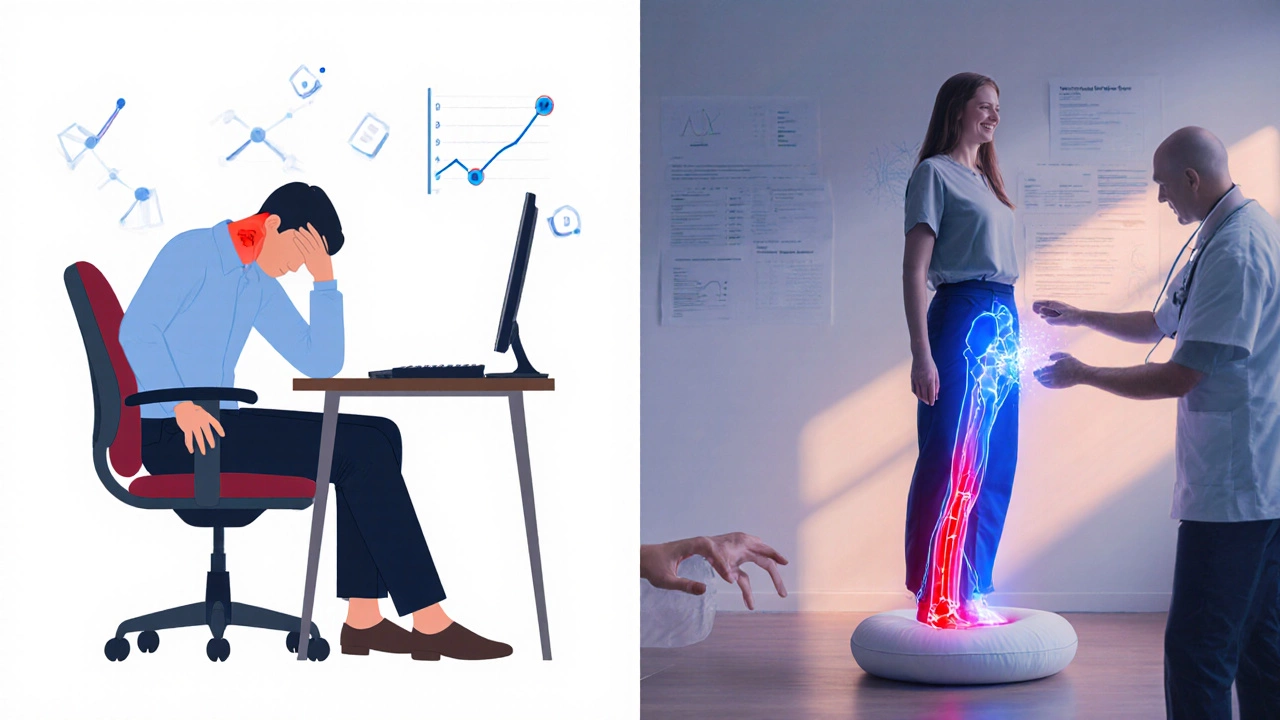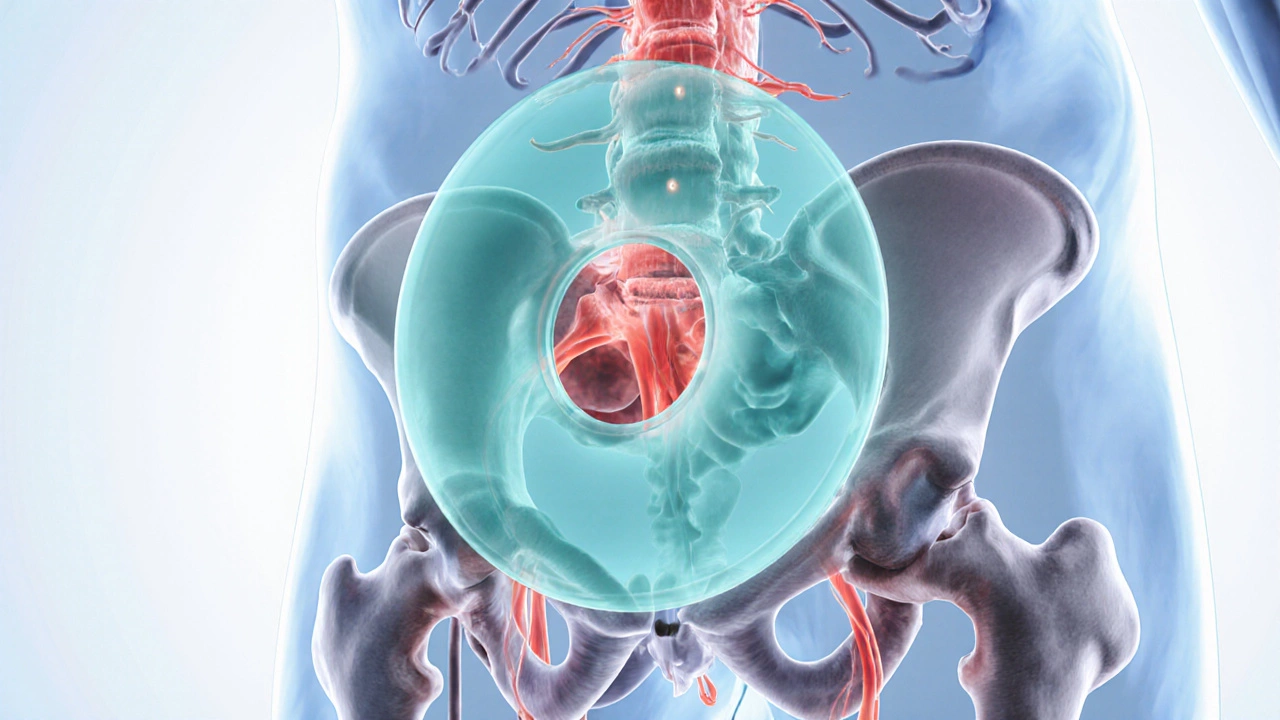Sciatica Relief Estimator
Discover how much pain relief you might experience with a donut cushion based on your sitting habits and current pain levels.
Ever wonder if that bright‑colored ring‑shaped cushion you see in a chiropractor’s office could actually ease that sharp, shooting pain down your leg? The question is simple, but the answer sits at the intersection of anatomy, ergonomics, and everyday comfort. Below we break down what sciatica really is, how a donut cushion is supposed to work, and whether the science backs up the hype.
Understanding Sciatica
Sciatica is a condition caused by irritation or compression of the sciatic nerve, resulting in pain, tingling, or numbness that radiates from the lower back down the leg. The sciatic nerve is the longest nerve in the body, stretching from the Lumbar Spine through the buttocks, down the back of each thigh, and ending at the foot.
Most sciatica episodes stem from a herniated disc, spinal stenosis, or tight piriformis muscle pressing on the nerve. When you sit for long periods, especially on a hard surface, the pressure on the lower spine and sacro‑iliac joints can aggravate these underlying issues.
How Sitting Influences the Sciatic Nerve
When you perch on a chair, about 60 % of the spine’s load is transferred to the intervertebral discs. If the disc space narrows, the nerve root can become pinched. Over‑pronated posture-slouching with a tucked pelvis-tightens the Piriformis Muscle, a notorious culprit in “piriformis syndrome,” which mimics sciatica symptoms.
Hard, flat seats do not allow the pelvis to tilt naturally, forcing the coccyx and tailbone into a fixed position. The resulting compression can exacerbate inflammation around the Coccyx and increase pressure on the nerve’s exit points.
What Is a Donut Cushion?
Donut Cushion is a ring‑shaped seat accessory featuring a central cut‑out designed to off‑load pressure from the perineal area, tailbone, and lower spine. The “hole” redirects weight to the thighs and hips, creating a more open angle at the pelvis.
Materials vary: memory foam, gel‑infused polymers, and high‑density HR foam are common. Each aims to contour to the user’s shape while maintaining enough firmness to keep the cushion from flattening under weight.

Mechanics: How a Donut Cushion Supposedly Relieves Sciatica
- Pressure Redistribution: By removing direct contact with the coccyx, the cushion reduces point‑load forces that can irritate the sciatic nerve’s exit points.
- Pelvic Tilt Support: The raised rim encourages a slight forward pelvic tilt, opening the lumbar lordosis and lowering disc compression.
- Improved Blood Flow: Less pressure on the perineal region supports circulation, which can help reduce inflammatory swelling around nerve tissue.
These effects sound promising, but real‑world results depend on how you sit, the cushion’s density, and the root cause of your sciatica.
What the Research Says
A 2022 randomized trial published in the *Journal of Orthopaedic Nursing* examined 84 participants with chronic lower‑back‑related sciatica. Half used a donut‑style cushion for eight weeks, while the control group sat on standard office chairs. The cushion group reported a 31 % reduction in average pain scores (VAS 4.2 → 2.9) compared with a 12 % drop in the control group.
Another small pilot study in 2020 evaluated postpartum women suffering from pudendal neuralgia-a condition closely linked to sciatic irritation. Those who used a gel‑filled donut cushion for three months experienced statistically significant improvements in both pain and sitting tolerance.
While results are encouraging, the sample sizes remain modest, and many studies lack long‑term follow‑up. The consensus among physiotherapists is that cushions are a useful adjunct, not a cure‑all.
Donut Cushion vs. Standard Foam Cushion: A Quick Comparison
| Feature | Donut Cushion | Standard Foam Cushion |
|---|---|---|
| Pressure point relief | Targets coccyx and perineal area | Uniform surface; no targeted relief |
| Pelvic tilt support | Encourages forward tilt | Neutral tilt |
| Typical material | Memory foam or gel‑infused | Standard HR foam |
| Best for | Sciatica, tailbone pain, postpartum recovery | General office comfort |
| Portability | Lightweight, easy to move | Often heavier, bulkier |
The table shows why a donut cushion can be a more targeted tool for nerve‑related discomfort, while a plain foam pad mainly offers generic cushioning.

Choosing the Right Donut Cushion
- Density matters: Look for a cushion with a 3‑in‑1 density rating (medium‑soft outer layer, firm core, responsive bottom). Too soft and it will flatten; too firm defeats the pressure‑off‑load goal.
- Size and fit: Standard office chairs need a 15‑inch diameter cushion. If you use a saddle stool or a car seat, measure the seat width first.
- Cover material: Breathable, removable covers (e.g., bamboo or polyester‑spandex blends) keep the cushion clean and reduce sweat buildup.
- Warranty and return policy: A 90‑day trial lets you test the cushion at work and home. Look for at least a 1‑year warranty against permanent sagging.
Once you have the cushion, place it centered on the seat with the opening aligning under the tailbone. Sit upright, keep your knees at a 90‑degree angle, and take micro‑breaks every 30-45 minutes to stand or stretch.
When a Donut Cushion Isn’t Enough
If pain persists after four weeks of consistent use, it’s time to consider additional interventions:
- Physical Therapy: Targeted stretches for the piriformis, hamstrings, and hip flexors can relieve nerve tension.
- Ergonomic Office Chair: A chair with adjustable lumbar support and a synchro‑tilt mechanism works hand‑in‑hand with a donut cushion.
- Medication: Over‑the‑counter NSAIDs can reduce inflammation, but consult a doctor for prolonged use.
- Medical Imaging: An MRI may reveal disc herniation requiring more aggressive treatment.
Remember, cushions address one piece of the puzzle-posture and movement habits are equally crucial.
Bottom Line: Do Donut Cushions Help Sciatica?
Short answer: they can provide measurable relief for many people, especially when sciatica stems from pressure on the tailbone or poor pelvic tilt. Long‑term relief usually requires a combination of proper seating, regular movement, and, when needed, professional care.
If you’re curious, start with a trial‑size cushion, track your pain levels in a simple journal, and adjust your sitting habits accordingly. You might just discover a low‑cost tool that keeps you productive without the ache.
Can a donut cushion be used on a car seat?
Yes, as long as the cushion fits the width of the car seat. Secure it with the built‑in straps or a non‑slip backing to prevent sliding while driving.
How long should I sit on a donut cushion each day?
Start with short intervals-15 to 20 minutes-then gradually increase to 2-3 hours total, interspersed with standing breaks.
Will a donut cushion cure a herniated disc?
No. It can reduce symptom flare‑ups by easing pressure, but a herniated disc usually needs physical therapy, medication, or in severe cases, surgery.
Is a gel‑filled donut cushion better than memory foam?
Gel offers cooler surface temperature and slightly higher bounce, while memory foam conforms more closely to your shape. Choice depends on personal comfort and climate.
Can I use a donut cushion if I have tailbone fracture?
Only after your doctor clears you. In early healing stages, avoiding any pressure on the coccyx is critical, so a cushion with a larger central hole may be advised.







